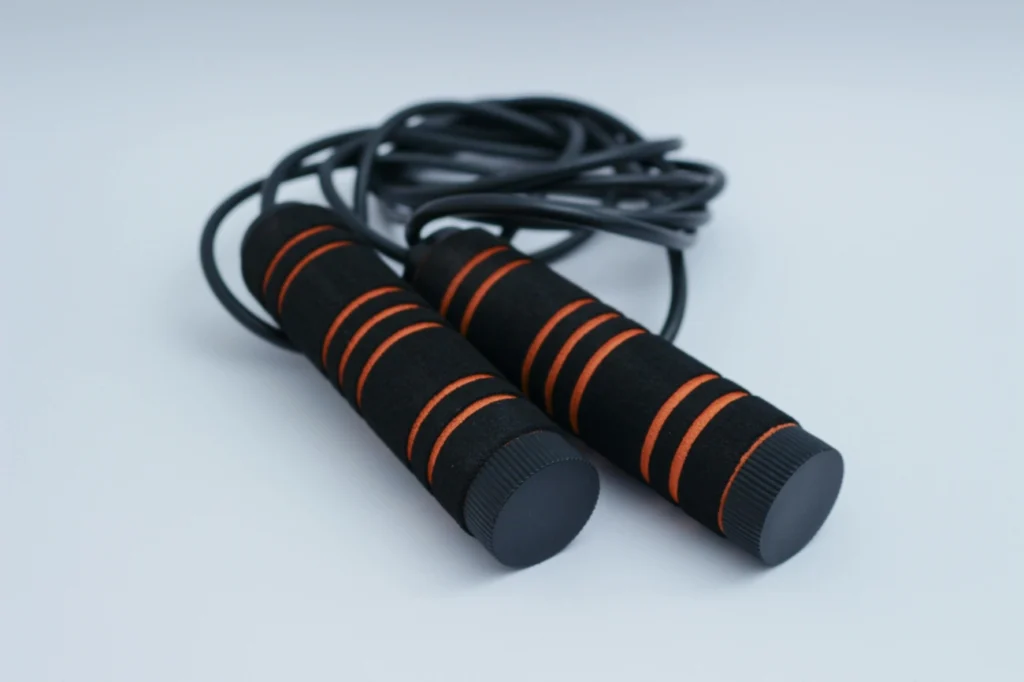The Science Behind Skipping Rope and Running Performance
When it comes to improving your running, skipping rope is more than just a fun exercise—it’s a powerful tool backed by science. Let’s break down exactly how skipping rope helps boost your running performance, touching on key areas like cardiovascular benefits, muscle engagement, and neuromuscular improvements.
Cardiovascular Benefits of Jump Rope for Runners
Jumping rope is an excellent way to enhance both aerobic and anaerobic capacity, two critical components for running endurance and speed. When you skip rope consistently, your heart and lungs get better at delivering oxygen during sustained activity (aerobic) and managing short bursts of intense effort (anaerobic). This improved cardiovascular endurance means you can maintain a faster pace longer and recover quicker between intervals.
Muscle Engagement for Running Efficiency
Skipping rope targets some of the same muscle groups that runners rely on every step of the way. The primary muscles involved include:
- Calves: Constant jumping strengthens the calves, helping with push-off power and ankle stability.
- Quadriceps: These front thigh muscles work hard to absorb impact and propel you forward.
- Core muscles: Your core stays engaged for balance and proper posture during both skipping and running.
- Glutes: The hip extensors provide driving force and support your stride mechanics.
By conditioning these muscles through jumping rope, you develop greater muscular endurance and strength, directly benefiting your running economy and form.
Coordination and Neuromuscular Improvements
One of the less obvious but highly important benefits of skipping rope is how it enhances coordination, balance, and timing. Efficient running depends on smooth, consistent foot strikes and stride rhythm. Skipping rope challenges your brain and muscles to work together through:
- Improved footwork and quick ground contact.
- Enhanced balance and stability during dynamic motion.
- Better neuromuscular control that fine-tunes your stride efficiency.
These improvements help you maintain efficient running strides, reduce energy wastage, and lower the risk of injury by promoting proper movement patterns.
In skipping rope acts as a low-impact cross training workout that boosts cardiovascular capacity, strengthens running muscles, and sharpens coordination – all essential for better running performance and endurance.
Key Benefits of Skipping Rope for Runners
Skipping rope offers a wide range of benefits for runners, making it a smart addition to any training routine. Here’s how jump rope exercises can boost your running performance:
Improved Cardiovascular Endurance and VO2 Max
Jump rope is a highly effective cardiovascular workout that improves both aerobic and anaerobic capacity. This boosts your VO2 max, which means your body can use oxygen more efficiently during runs. Better cardiovascular endurance helps you maintain faster paces for longer distances without getting tired as quickly.
Enhanced Foot Speed Agility and Reaction Time
Skipping rope trains your footwork, balance, and rhythm, all of which are crucial for quick, efficient running strides. It sharpens your agility and reaction time, letting you respond faster during races or trail runs where quick changes in pace or direction are necessary.
Increased Muscular Endurance and Strength in Lower Legs
The repetitive jumping action targets key muscles like your calves, quads, core, and glutes, boosting muscular endurance and strength. Stronger lower legs improve your push-off power and help maintain form during long runs. This conditioning also supports tendon and ligament health, which is essential for injury prevention.
Better Running Economy and Energy Efficiency
Regular jump rope sessions improve your gait and posture, making your running stride smoother and more energy-efficient. This translates to less wasted energy per step, so you can run faster with less effort. Developing a consistent rhythm with skipping also helps maintain a steady pace during runs.
Injury Prevention Through Low Impact Plyometrics
Unlike some high-impact workouts, skipping rope provides low-impact plyometric conditioning that strengthens your tendons, ligaments, and joints without excessive strain. This conditioning enhances durability and reduces the risk of common running injuries like shin splints or Achilles tendonitis.
Mental Focus and Rhythm for Better Pace Control
The repetitive nature of skipping rope fosters mental focus and a meditative rhythm, helping runners develop better pacing skills. Being in tune with your cadence and breathing during jump rope drills translates directly into improved control over your running pace and endurance.
Skipping rope truly complements running by blending cardiovascular, muscular, and neurological improvements. For those looking to add jump rope to their cross training, choosing the right rope is key—check out our best jump ropes for running training to get started with quality gear designed for runners.
How to Incorporate Skipping Rope into Your Running Training

Adding skipping rope to your running routine is a smart way to boost speed, endurance, and coordination. Here’s how to do it right without overdoing it.
Ideal Frequency and Duration for Runners
For most runners, jump rope sessions 3 to 4 times per week work well. Keep each session between 10 to 20 minutes to avoid fatigue while still gaining cardiovascular and muscular benefits. This fits easily into a weekly training schedule without interfering with running mileage.
Warm Up with Jump Rope Before Runs
Using a jump rope as part of your warm-up gets your heart rate up and activates key running muscles like calves, quads, and glutes. Spend about 5 minutes of light skipping focusing on rhythm and smooth footwork. This primes your neuromuscular system for more efficient strides.
Use Interval Training with Jump Rope to Boost Speed
Jump rope intervals are a great way to supplement speed workouts. Try these tips:
- Alternate between 30 seconds of fast skipping and 30 seconds of rest for 5 to 10 rounds.
- Incorporate different jump styles like double-unders or high knees to challenge coordination and agility.
This kind of jump rope cross training for running improves foot speed, reaction time, and anaerobic capacity, helping you sprint or pick up pace mid-run.
Active Recovery Days with Light Jump Rope Sessions
On recovery or easy days, keep jump rope sessions light and low-impact—about 5 to 10 minutes. Gentle skipping promotes blood flow and tendon flexibility without stressing tired muscles. This supports injury prevention and quicker recovery.
Sample Weekly Plan Combining Running and Jump Rope
Here’s an example plan to get started:
| Day | Running | Jump Rope |
|---|---|---|
| Monday | Easy run 3 miles | 10 minutes light jump rope warm-up |
| Tuesday | Speed intervals 6 x 400m | 15 minutes jump rope intervals |
| Wednesday | Rest or active recovery | 5-10 minutes gentle jump rope |
| Thursday | Tempo run 4 miles | 10-15 minutes jump rope drills |
| Friday | Easy run or cross-training | Optional light jump rope session |
| Saturday | Long run 6+ miles | Rest or no jump rope |
| Sunday | Recovery day or cross-training | 5 minutes easy jump rope |
This balanced plan blends jump rope muscle conditioning with running workouts to boost overall performance while minimizing injury risks.
Incorporating jumping rope into your running training this way not only improves endurance and speed but also enhances your form and mental focus—key factors for hitting your running goals consistently.
Choosing the Right Jump Rope for Runners
Selecting the best jump rope for running cross training can make a significant difference in your workouts. Different rope types serve specific purposes, so it’s important to pick one that matches your running goals and training style.
Rope Types Best Suited for Running Cross Training
- Speed Ropes: These are lightweight with thin cables designed for fast rotations. Perfect for improving foot speed, agility, and reaction time—key benefits when you’re looking to boost your running performance.
- Weighted Ropes: Heavier ropes add resistance, helping to build muscular endurance and strength especially in the calves, quads, and core, which all support your running muscles.
- Adjustable Ropes: These allow you to customize the length according to your height and training preferences, ensuring proper form and reducing injury risk.
- Beaded or PVC Ropes: Durable and great for beginners, these help you build coordination and rhythm before moving to faster ropes.
What to Look for in a Jump Rope for Runners
- Correct Length: A rope that’s too long or short can throw off your rhythm and cause tripping. To check the right length, stand on the middle of the rope—handles should reach just below your armpits.
- Durability: Frequent jump rope workouts demand a rope that can withstand regular wear. Look for high-quality materials like PVC cables or braided steel cables with protective coating.
- Comfortable Handles: Handles with good grip and ergonomic design reduce hand fatigue and improve control, especially during longer sessions.
- Smooth Rotation: Bearings in handles ensure smooth, fast rope rotation for efficiency and speed. This directly impacts your ability to do high-intensity intervals that benefit running speed.
Why Quality Matters
Using a quality jump rope like the ones from JumpRopeManufacturer optimizes your performance and keeps you safe. Cheap or poorly made ropes can break mid-session or cause injury due to uneven rotation and grip issues. Investing in a well-made rope ensures consistency in your training, helping you build endurance, coordination, and speed without interruptions.
For example, check out our ball bearing skipping rope for smooth rotation and enhanced durability — perfect for runners looking to improve footwork drills and muscle conditioning. Ball Bearing Skipping Rope
Choosing the right jump rope tailored for your running training maximizes the cardiovascular and muscle benefits, making your cross training both effective and enjoyable.
Common Mistakes to Avoid When Using Skipping Rope for Running
Skipping rope is an excellent cross-training tool for runners, but it’s important to use it correctly to gain the full benefits of jump rope for runners while avoiding setbacks like fatigue or injuries. Here are some common pitfalls to watch out for:
Overdoing Jump Rope Can Lead to Fatigue and Injuries
It’s easy to get carried away with jump rope workouts, especially since they’re fun and effective. However, overtraining with jump rope can cause:
- Excess muscle fatigue that negatively affects your running performance
- Stress on joints, tendons, and ligaments, increasing injury risk
- Burnout that might force you to skip running or rest days
To prevent this, stick to recommended sessions—3 to 4 times per week for 10 to 20 minutes—and listen to your body. Gradually build intensity rather than jumping into long or high-frequency workouts.
Poor Skipping Form Can Hurt Running Biomechanics
Your form when jumping rope directly impacts how your body moves during running. Common mistakes like:
- Landing too hard on your heels
- Excessive bouncing or high jumps
- Poor posture or slouching
can throw off your running gait and efficiency. This may lead to decreased running economy and even discomfort or injury.
Focus on:
- Keeping a soft, controlled landing on the balls of your feet
- Maintaining an upright posture with engaged core
- Using smooth, rhythmic jumps to enhance footwork drills for runners
Practicing proper form enhances both your skip rope sessions and your running stride.
Ignoring Rest and Muscle Recovery Hinders Progress
Skipping rope is a plyometric workout that stresses your muscles, especially calves, quads, glutes, and core. Without adequate recovery, these muscles become tight, imbalanced, or overworked, which can reduce your running performance and increase injury risk.
Make sure to:
- Schedule rest days or light jump rope sessions to allow muscle recovery
- Incorporate stretching and mobility work focusing on lower legs and hips
- Pay attention to soreness and reduce skipping intensity when needed
Balancing work and rest is key to benefiting from jump rope muscle conditioning while minimizing setbacks.
Avoiding these mistakes helps you maximize the jump rope cardiovascular benefits and muscular improvements that directly translate to better running speed, agility, and endurance. Stick to good form, reasonable volume, and proper recovery to get the best out of your jump rope training for running.
Testimonials and Success Stories from Runners Using Skipping Rope
Many runners across the U.S. have found skipping rope to be a game-changer in boosting their running performance and stamina. Take Sarah, a marathon runner from Denver, who shared how incorporating jump rope exercises into her weekly routine helped improve her cardiovascular endurance and foot speed. “After just a few weeks of jump rope cross training, my pace tightened, and I felt less fatigued during long runs,” she says.
Professional coaches and physiotherapists also back skipping rope as an effective training tool for runners. Coach Mike Reynolds, who trains college-level athletes, highlights that jump rope muscle conditioning translates directly to better running form and injury prevention. “The coordination and neuromuscular benefits from skipping rope help runners maintain balance and rhythm, which are key to efficient strides,” he explains.
Physiotherapist Dr. Lisa Chang adds that skipping rope is excellent for strengthening tendons and ligaments, which reduces common running injuries. “Jump rope workouts provide a safe, low-impact way to build muscular endurance and enhance joint stability,” she notes for her clients.
Key takeaway from runners and experts
- Improved stamina and speed thanks to enhanced cardiovascular fitness from skipping rope cardiovascular benefits
- Better footwork and agility leading to smoother, faster running strides
- Injury prevention by strengthening muscles, tendons, and ligaments with low-impact plyometric training
- Mental focus and rhythm aiding in pace control and running efficiency
If you’re aiming to improve your running with cross training, jump rope exercises are a simple and effective solution that many runners and professionals recommend.



